Struggling with parts that rust, wear out, or just look dull? This can be frustrating and costly. Chromium plating offers a tough, shiny solution that protects and beautifies metal surfaces.
Chromium is widely used for electroplating because it provides excellent corrosion resistance, increases surface hardness, improves wear resistance, reduces friction, and offers a bright, decorative, mirror-like finish that is very appealing.
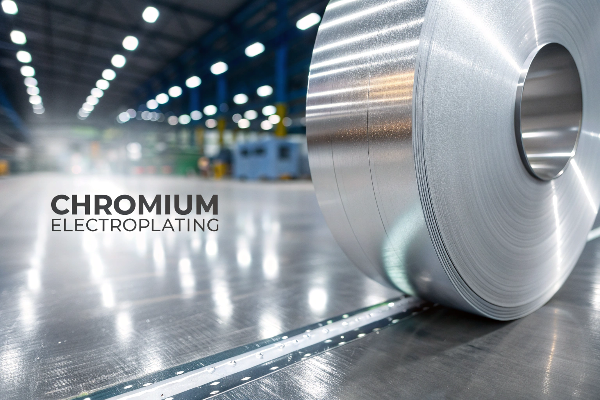
So, you see that chromium offers a lot of advantages. But let’s dig a bit deeper into why it’s such a popular choice and explore some specific questions people often ask about the process.
What is the purpose of chromium plating?
Worried about metal components breaking down too quickly? Constant replacement eats into your budget and time. Chromium plating provides a durable layer, extending the lifespan and look of your parts.
The main purposes of chromium plating1 are to provide a decorative finish, increase resistance to corrosion and tarnish, enhance surface hardness and durability, reduce friction, and improve wear resistance2 on metal objects.
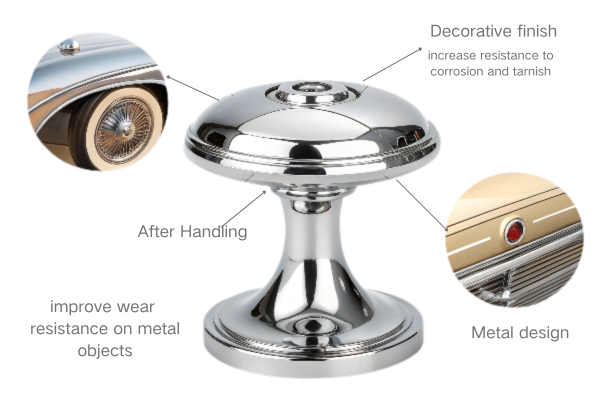
Let’s break down these purposes further. When I first got into restoring old bicycles, I quickly learned the difference chromium plating1 makes. An unplated steel handlebar would rust within weeks if left outside, while a chrome-plated one stayed bright for years. It’s not just about looks, though that’s a big part.
Decorative Appeal
Chrome provides that bright, bluish-white, highly reflective finish many people associate with quality and durability. Think about classic cars, motorcycles, or even modern kitchen fixtures. That shine is often achieved through decorative chromium plating1, which typically involves a thin layer of chromium over layers of nickel and sometimes copper.
Protection and Durability
This is where functional or "hard" chrome plating comes in. It involves applying a much thicker layer of chromium directly onto the base metal (usually steel). This dramatically improves several properties:
- Corrosion Resistance: Chromium forms a passive oxide layer that protects the underlying metal from rust and other forms of corrosion.
- Hardness: Hard chrome is extremely hard, significantly increasing the surface strength of the component.
- Wear Resistance: This hardness translates directly into excellent resistance against abrasion and wear, making parts last much longer in demanding applications.
- Low Friction: Chrome surfaces have a low coefficient of friction, which is beneficial for moving parts like hydraulic cylinders or engine components.
Here’s a simple comparison:
| Feature | Unplated Steel Component | Chrome Plated Steel Component |
|---|---|---|
| Appearance | Dull, prone to rust | Bright, shiny, reflective |
| Corrosion | Poor resistance | Excellent resistance |
| Hardness | Base metal hardness | Significantly harder surface |
| Wear Resistance | Lower | Much higher |
| Lifespan | Shorter | Significantly longer |
So, whether for looks or for function, chromium plating1 serves vital purposes in extending the life and improving the quality of metal parts.
Why is lead used as anode in chromium plating?
Confused about why lead is used in the chromium plating process? Using the wrong material can ruin the plating bath. Lead anodes are chosen for a specific, crucial reason related to the chemistry involved.
Lead (or specific lead alloys like lead-tin or lead-antimony) is used as the anode in traditional chromium plating primarily because it is relatively inert in the highly corrosive chromic acid plating bath3.
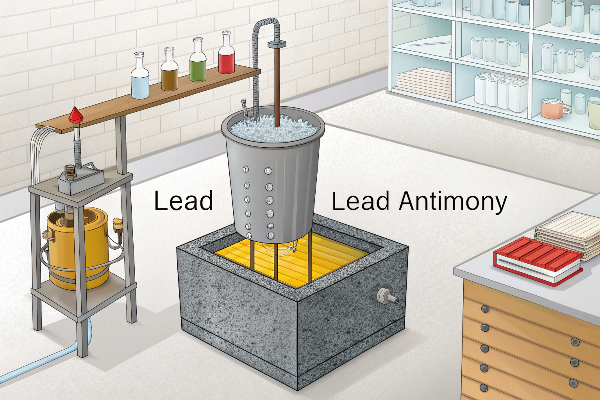
Understanding the anode’s role requires looking at the electroplating setup4. You have a tank filled with the electrolyte (chromic acid solution), the part you want to plate (the cathode, or negative electrode), and an anode (the positive electrode). When electricity flows, metal ions from the solution deposit onto the cathode. The anode completes the circuit. In many plating processes, the anode dissolves to replenish metal ions in the solution. But chromium plating is different.
The Challenge of Chromic Acid
Chromic acid (CrO₃ dissolved in water with sulfuric acid as a catalyst) is extremely corrosive and oxidizing. Most metals, if used as an anode, would rapidly dissolve or corrode in this solution, contaminating the bath and disrupting the plating process.
Why Lead Works
Lead and its alloys have a unique property in this environment.
- Formation of Lead Dioxide5: When current passes, the lead anode surface forms a layer of lead dioxide (PbO₂).
- Inertness: This lead dioxide layer is electrically conductive but chemically resistant to the chromic acid bath. It doesn’t readily dissolve.
- Oxygen Evolution6: Instead of dissolving, the primary reaction at the lead anode is the electrolysis of water, producing oxygen gas. It also helps re-oxidize trivalent chromium (Cr³⁺), an undesirable byproduct that builds up in the bath, back to hexavalent chromium (Cr⁶⁺), which is needed for plating.
| Anode Material | Reaction in Chromic Acid Bath | Suitability for Chrome Plating |
|---|---|---|
| Lead Alloy7 | Forms stable PbO₂ layer, evolves O₂ | Suitable |
| Steel | Rapidly corrodes, contaminates bath | Unsuitable |
| Chromium | Dissolves, disrupts bath balance | Unsuitable (see next section) |
| Platinum | Inert, but very expensive | Technically suitable, costly |
So, lead anodes are used not because they actively participate by dissolving, but precisely because they resist dissolving while still conducting electricity and facilitating the necessary chemical reactions in the aggressive plating solution.
Why is chromium not used as anode in electroplating?
Thinking it would make sense to use a chromium anode8 to plate chromium? It seems logical, but it causes major problems. Using chromium as the anode actually prevents the plating process from working correctly.
Chromium is not used as the anode in conventional chromium electroplating because it would dissolve too readily in the chromic acid bath, leading to an uncontrolled buildup of chromium ions and disrupting the delicate chemical balance required for plating.
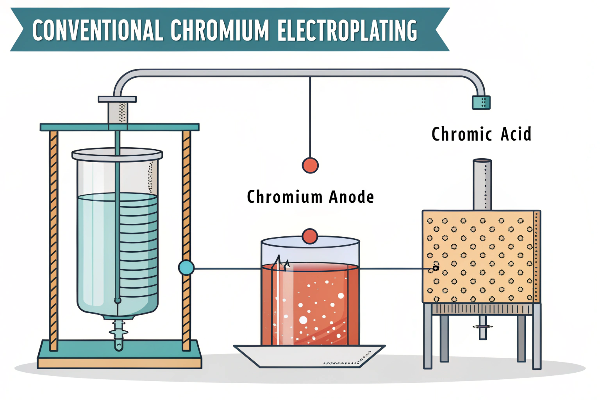
This might seem counter-intuitive. In many other electroplating processes, like copper plating or nickel plating, an anode made of the plating metal is used. This is called a soluble anode, and it dissolves gradually to replenish the metal ions in the plating bath as they are deposited onto the cathode. It works because the rate of anode dissolution9 can often be balanced with the rate of cathode deposition.
The Problem with a Chromium Anode
Chromium plating, especially using traditional hexavalent chromium baths10, operates under very specific chemical conditions.
- Bath Chemistry: The concentration of hexavalent chromium ions (Cr⁶⁺) and the ratio of chromic acid to the sulfate catalyst are critical.
- Anode Dissolution: If a pure chromium anode8 were used, it would dissolve chemically and electrochemically in the chromic acid. This dissolution is hard to control.
- Unbalanced Ions: The dissolving chromium anode8 would add more chromium ions (likely a mix of Cr³⁺ and Cr⁶⁺) to the bath than are being plated out onto the cathode.
- Poor Plating Quality: This imbalance disrupts the bath chemistry, leading to poor quality deposits, low efficiency, or even preventing plating altogether. The excess trivalent chromium (Cr³⁺) is particularly problematic.
Insoluble Anodes are Key
This is why insoluble anodes, like the lead alloys11 discussed previously, are essential for traditional chromium plating12. They allow the plating reaction to occur at the cathode without adding excess metal ions from the anode. The chromium ions for plating come solely from the chromic acid already in the bath solution.
| Feature | Soluble Anode (e.g., Copper in Copper Plating) | Insoluble Anode (e.g., Lead in Chrome Plating) | Chromium Anode (Hypothetical) |
|---|---|---|---|
| Material | Same as plating metal (Copper) | Inert material (Lead Alloy) | Chromium |
| Function | Dissolves to replenish metal ions | Conducts current, facilitates bath chemistry | Dissolves uncontrollably |
| Bath Impact | Maintains metal ion concentration | Does not add metal ions | Increases Cr ions, imbalances |
| Suitability | Suitable for some processes | Required for Chrome Plating | Unsuitable for Chrome Plating |
Therefore, using chromium as an anode is avoided because it would actively work against maintaining the stable conditions needed for successful chromium electroplating.
Why is chromium used for electroplating brainly?
Searching online, maybe on sites like Brainly, for why chromium plating is used? You need a simple, clear answer. Chromium is popular because it makes metal things look shiny, stops them from rusting, and makes them harder to scratch.
Chromium is used for electroplating primarily because it gives objects a very bright, shiny appearance (like mirrors), protects them from rusting or corroding, and makes their surfaces much harder and more resistant to scratches and wear.
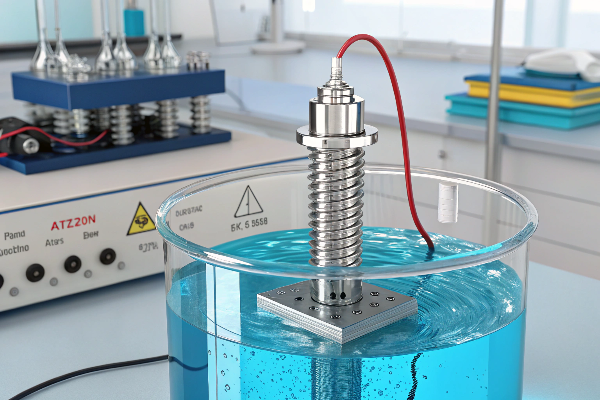
Think about it in simple terms. Imagine you have a bicycle handlebar made of plain steel.
- Problem 1: Rust. If it gets wet, it starts to rust and looks ugly.
- Problem 2: Scratches. If it bumps against something, it can easily get scratched.
- Problem 3: Dull Look. Plain steel isn’t very shiny.
Electroplating with chromium solves these problems. It’s like giving the handlebar a very thin, but very strong and shiny, metal coat.
Key Benefits Explained Simply
- Shiny Look (Decorative): The chrome layer is super reflective, like a mirror. This makes things look attractive and clean. Think of shiny car bumpers or bathroom faucets. This is often called ‘decorative chrome’.
- Rust Prevention (Corrosion Resistance): The chromium coating acts like a shield, stopping water and air from reaching the steel underneath. This prevents rust and keeps the part looking good for longer.
- Hardness (Wear Resistance): Chromium is a very hard metal. The plated layer makes the surface much tougher and less likely to get scratched or worn down from rubbing. This is important for tools or machine parts and is often called ‘hard chrome’.
Why it’s Done By Electroplating
Electroplating is the process used to apply this thin chromium coat.
- Electricity: It uses electricity to move tiny particles of chromium from a special chemical bath onto the object.
- Even Coat: This method ensures the chromium coat is even and sticks well to the metal surface.
| Feature | Why It’s Good (Simple Terms) | Example |
|---|---|---|
| Appearance | Makes things shiny | Car Bumpers |
| Protection | Stops rust | Bathroom Faucets |
| Hardness | Prevents scratches/wear | Tools, Bike Parts |
So, in short, chromium plating13 is used because it’s a great way to make metal objects14 look better, last longer, and resist damage from rust and scratches.
Why is chromium preferred for electroplating?
Wondering why, out of all metals, chromium is so often the top choice for plating? While other metals are used, chromium offers a unique combination of benefits. It’s preferred because it excels in several key areas simultaneously.
Chromium is preferred for electroplating due to its unique combination of high hardness15, excellent wear and corrosion resistance16, low coefficient of friction, and its ability to provide a highly reflective, aesthetically pleasing decorative finish17.
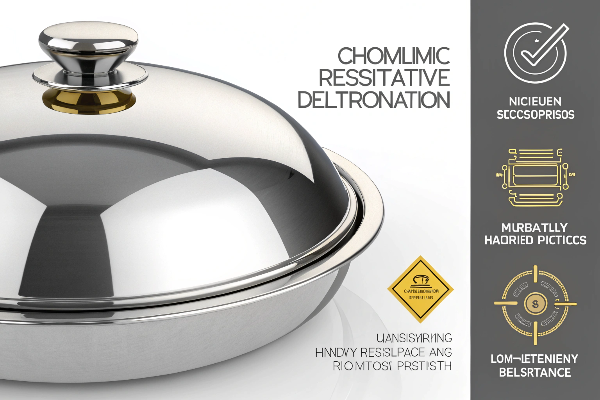
Many materials can be electroplated, like nickel, zinc, copper, gold, and silver. Each has its own advantages. Zinc is great for cheap corrosion protection (galvanizing), gold is used for electrical contacts and decoration, and nickel provides a good underlayer and its own finish. But chromium stands out for several reasons, making it the preferred choice for many applications.
Unbeatable Combination of Properties
It’s the combination of chromium’s properties that makes it so valuable:
- Extreme Hardness18: Hard chrome plating is one of the hardest electroplated finishes available, significantly exceeding the hardness of most steels and other plated metals like nickel. This directly translates to superior wear resistance.
- Superior Corrosion Resistance19: The passive oxide film formed on chromium provides excellent protection against atmospheric corrosion, moisture, and many chemicals.
- Aesthetic Appeal20: Decorative chromium offers a unique bright, bluish-white, highly reflective finish that is considered very attractive and durable. It resists tarnishing exceptionally well compared to silver or even nickel alone.
- Low Friction: Chromium surfaces are smooth and have a low coefficient of friction, which is advantageous for moving parts, reducing energy loss and wear.
- Versatility: It can be applied as thin decorative layers or thick functional coatings (hard chrome) depending on the need.
Comparing Chromium to Alternatives
| Feature | Chromium | Nickel | Zinc (Galvanized) |
|---|---|---|---|
| Hardness | Very High | Moderate | Low |
| Wear Resistance | Excellent | Good | Poor |
| Corrosion Res. | Excellent | Good (but can tarnish) | Good (sacrificial) |
| Appearance | Bright, bluish-white, shiny | Yellowish-white, shiny | Dull grey/mottled |
| Friction | Low | Moderate | Higher |
| Primary Use | Decoration, Wear, Corrosion | Underlayer, Decoration | Corrosion (sacrificial) |
While processes like nickel plating are often used underneath decorative chrome for better adhesion and corrosion protection, the final chromium layer adds that ultimate hardness, tarnish resistance, and characteristic shine. For demanding applications requiring extreme surface durability (like hydraulic cylinders, piston rings, molds), hard chrome often has no practical substitute. This powerful combination of function and beauty makes chromium a preferred choice in countless industries.
Conclusion
In summary, chromium is a top pick for electroplating because it delivers hardness, wear resistance, corrosion protection, low friction, and that sought-after bright, decorative shine all in one package.
-
Explore the benefits of chromium plating to understand how it can enhance durability and appearance of metal parts. ↩ ↩ ↩ ↩
-
Discover how chromium plating enhances wear resistance, making components last longer in demanding environments. ↩
-
Learn about the significance of chromic acid in plating baths and its effects on the electroplating process. ↩
-
Discover the components of an electroplating setup and how they work together in the plating process. ↩
-
Understanding the formation of lead dioxide is crucial for optimizing electrochemical applications and improving efficiency. ↩
-
Exploring oxygen evolution can enhance your knowledge of electrolysis and its applications in various industries. ↩
-
Discover the advantages of lead alloys in chrome plating to understand their unique properties and applications. ↩
-
Understanding the issues with chromium anodes can enhance your knowledge of electroplating processes and their chemistry. ↩ ↩ ↩
-
Exploring this topic will provide insights into the balance required in electroplating and the chemistry involved. ↩
-
Learning about hexavalent chromium baths can deepen your understanding of their critical role in successful electroplating. ↩
-
Discover the properties and applications of lead alloys in electroplating, crucial for understanding their role in the industry. ↩
-
Learn about the chromium plating process and its various applications, which can deepen your knowledge of metal finishing techniques. ↩
-
Explore the advantages of chromium plating to understand how it enhances durability and appearance of metal objects. ↩
-
Discover effective methods to protect metal objects from rust and extend their lifespan. ↩
-
Understanding high hardness in chromium can reveal why it’s essential for durability and performance in various applications. ↩
-
Exploring wear and corrosion resistance can help you appreciate chromium’s longevity and effectiveness in protective coatings. ↩
-
Discover how chromium enhances the visual appeal of products, making it a popular choice for decorative applications. ↩
-
Explore how Extreme Hardness in chromium plating enhances durability and wear resistance, making it ideal for demanding applications. ↩
-
Learn about the exceptional corrosion resistance of chromium and its advantages over other metals like nickel and zinc. ↩
-
Discover the unique aesthetic qualities of chromium finishes and why they are preferred for decorative applications. ↩





